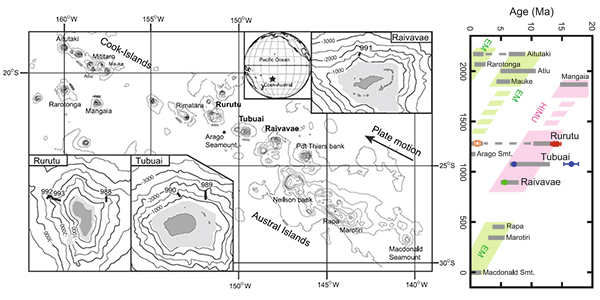
-Publication-
Geochemical diversity in submarine HIMU basalts from Austral Islands, French Polynesia
Takeshi Hanyu 1 , Laure Dosso 2, Osamu Ishizuka 3, Kenichiro Tani 1, Barry B. Hanan 4, Claudia Adam 5, Shun’ichi Nakai 6, Ryoko Senda 1, Qing Chang 1, and Yoshiyuki Tatsumi1 7
(1) Institute for Research on Earth Evolution, Japan Agency for Marine-Earth Science and Technology, Yokosuka 237-0061, Japan
(2) Centre National de la Recherche Scientifique, UMR 6538, IFREMER, BP70, 29280 Plouzané, France
(3) Institute of Geology and Geoinformation, Geological Survey of Japan/AIST, Tsukuba 305-8567, Japan
(4) Department of Geological Sciences, San Diego State University, San Diego, CA 92182-1020, USA
(5) Centro de Geofísica, Universidade de Évora, 7002-554 Évora, Portugal
(6) Earthquake Research Institute, The University of Tokyo, Tokyo 113-0032, Japan
(7)Earth and Planetary Sciences, Kobe University, Kobe 657-8501, Japan
Abstract
We present the first report of geochemical data for submarine basalts collected by a manned submersible from Rurutu, Tubuai, and Raivavae in the Austral Islands in the South Pacific, where subaerial basalts exhibit HIMU isotopic signatures with highly radiogenic Pb isotopic compositions. With the exception of one sample from Tubuai, the 40Ar/39Ar ages of the submarine basalts show no significant age gaps between the submarine and subaerial basalts, and the major element compositions are indistinguishable at each island. However, the variations in Pb, Sr, Nd, and Hf isotopic compositions in the submarine basalts are much larger than those previously reported in subaerial basalts. The submarine basalts with less-radiogenic Pb and radiogenic Nd and Hf isotopic compositions show systematically lower concentrations in highly incompatible elements than the typical HIMU basalts. These geochemical variations are best explained by a two-component mixing process in which the depleted asthenospheric mantle was entrained by the mantle plume from the HIMU reservoir during its upwelling, and the melts from the HIMU reservoir and depleted asthenospheric mantle were then mixed in various proportions. The present and compiled data demonstrate that the HIMU reservoir has a uniquely low 176Hf/177Hf decoupled from 143Nd/144Nd, suggesting that it was derived from an ancient subducted slab. Moreover, the Nd/Hf ratios of the HIMU basalts and curvilinear Nd–Hf isotopic mixing trend require higher Nd/Hf ratios for the melt from the HIMU reservoir than that from the depleted mantle component. Such elevated Nd/Hf ratios could reflect source enrichment by a subducted slab during reservoir formation.


